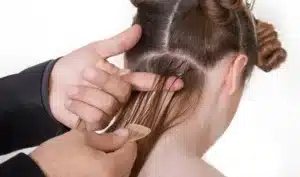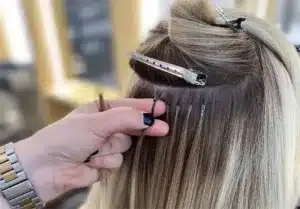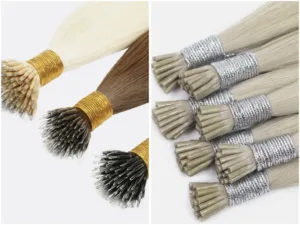Sewn-in extensions have been a trusted choice in salons for decades, and they remain one of the most effective ways to create dramatic transformations. They offer volume, length, and a sense of security that many clients demand. However, like all professional methods, they come with trade-offs that must be carefully understood.
Sewn hair extensions deliver strong hold, reusability, and a long lifespan when installed with premium hair. On the downside, they can cause scalp tension, require professional skill, and demand consistent aftercare. Whether braided or beaded-row, the method you choose defines both the experience and the outcome.

Stylists and clients must weigh the strengths and weaknesses. Let’s explore both sides in detail, with a clear focus on what makes sew-ins such a powerful yet demanding option.
What are sew in hair extensions?
Sewn-in extensions are one of the oldest and most reliable systems in the industry, but the definition has evolved. Traditionally, they were anchored by cornrow braids, but now beads are widely used as the base.
Sewn hair extensions involve stitching wefts onto either braided bases or beaded rows, creating a secure attachment that lasts for weeks. Both are considered sewn-in because thread is always used as the final locking mechanism.
Dive Deeper: Classic vs. Modern Methods
The classic braided sew-in involves creating cornrows across the scalp and sewing wefts into these braids. This approach offers strong anchoring and works especially well for clients with textured or thick hair. It has been a staple method for decades and remains popular in certain markets.
The modern beaded-row sew-in eliminates braids. Instead, silicone-lined beads are placed along the scalp in rows, clamped flat, and used as the foundation for stitching. This method is now dominant in luxury salons because it creates a flatter, more natural finish, reduces installation time during move-ups, and avoids the heavy, tight feeling of braids.
Types of Wefts Used:
- Machine Wefts: Thick and durable, suitable for braided installs.
- Hand-Tied Wefts: Extremely thin and natural-looking, ideal for beaded rows.
- Genius Wefts: Seamless, lightweight, cuttable without shedding, the most flexible option.
- Volume Wefts: Designed for maximum density, often used in braided sew-ins.
| Method | Base | Best For Wefts | Pros | Cons |
|---|---|---|---|---|
| Braided Sew-In | Cornrows | Machine, Volume | Maximum density, very secure | Less flat, tight at first, slower move-ups |
| Beaded-Row Sew-In | Silicone beads | Hand-tied, Genius | Flatter profile, faster maintenance | Needs precise sectioning, not ideal for ultra-dense installs |
Both approaches share the same principle—thread locks the weft in place. The choice depends on hair type, client preference, and the stylist’s specialty.
Different Wefts of Sew-In Hair Extensions
1
While many might consider sew-in extensions to be a monolithic category, the variety of weft types says otherwise. Here’s a closer look:
Machine Weft: Made using a machine, these are sturdy and thick. Their robust nature makes them long-lasting, and they can cater to large volumes of hair. However, due to their thickness, they might not lay as flat as some other types.
1
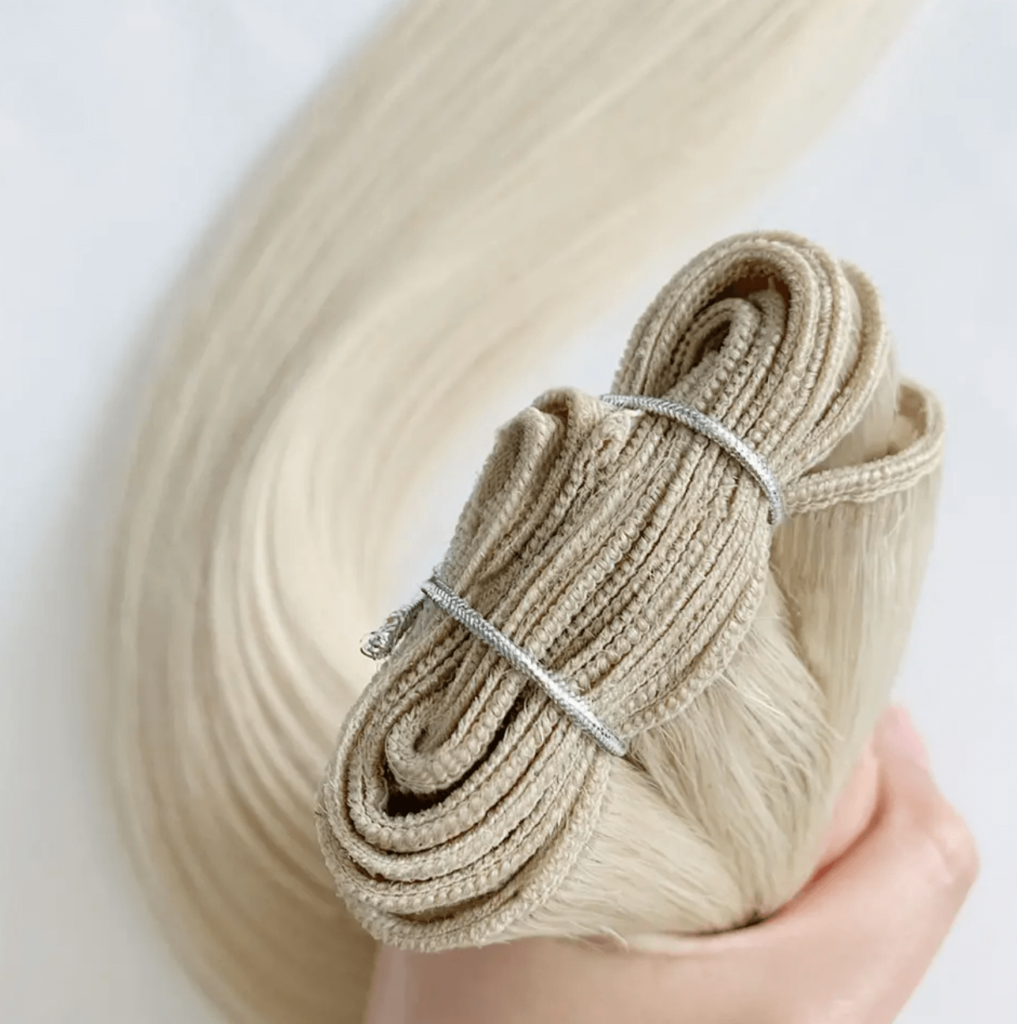
1
Hand-Tied Weft: As the name suggests, these are crafted by hand, making them thinner than machine wefts. Their delicate nature allows them to sit flatter against the head, offering a more natural look.
1

1
Genius Weft: This type combines hand-tied and machine weft techniques. It’s designed to be thin yet durable. No return hair makes it more comfortable and is less prone to shedding when cut.
1

1
1
Flat Weft: Flat wefts are essentially an evolved version of machine wefts. They’re designed to provide the sturdiness of machine wefts but with the added benefit of lying flatter against the head, much like hand-tied wefts.
1

1
1
PU Weft: Also termed skin wefts by some brands, they have a thin, flexible polyurethane base. This ensures they lie flush against the scalp, giving a natural appearance.
1

Sew in extensions pros and cons?
Every professional method has advantages and limitations. Sew-ins deliver reliability but also require careful consideration.
The pros of sew-in extensions include long-lasting wear, security during daily activities, and the ability to reuse premium wefts. The cons include possible scalp tension, longer installation times, and the need for consistent aftercare.
Dive Deeper: Evaluating the Trade-Offs
Advantages:
- Longevity: A single installation lasts 6–8 weeks, making them one of the longest-lasting salon methods.
- Security: They hold firmly, even during workouts, swimming, or active lifestyles.
- Reusability: With full cuticle hair, the same wefts can be reused for 9–18 months.
- Versatility: Suitable for clients seeking dramatic volume, length, or both.
- No Harsh Adhesives: They do not rely on glue or tapes, lowering chemical exposure.
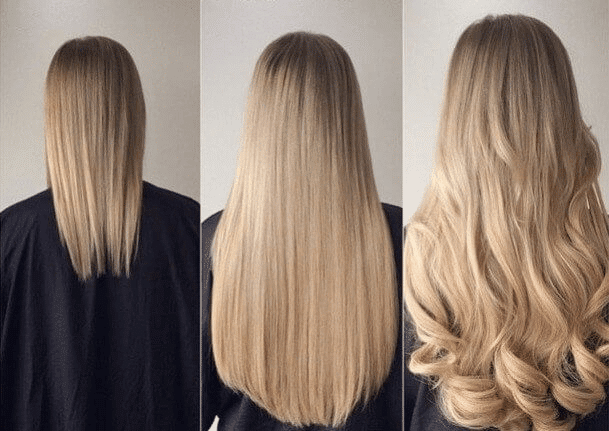
Disadvantages:
- Tension: If braided or stitched too tightly, scalp tenderness and stress can occur.
- Time: Installations typically take 2–4 hours. Maintenance also requires commitment.
- Scalp Care: Washing and drying thoroughly under the wefts can be challenging.
- Not Universal: Very fine or fragile hair may struggle with the weight unless carefully adapted.
- Professional Skill: Success depends heavily on the stylist’s expertise and stitch technique.
| Pros | Cons |
|---|---|
| Long-lasting per install | Can cause tension if over-tight |
| Very secure | Time-intensive installation |
| Reusable premium wefts | Requires salon expertise |
| Active lifestyle safe | More complex wash/dry routine |
| Customizable density | Higher learning curve for stylists |
Clients who want the most durable and reliable system often choose sew-ins, while those who prefer speed and lower maintenance might opt for tape-ins.
Are sew in extensions bad for your hair?
Concerns about damage are common. The truth is that the method itself is not harmful—the risk lies in improper execution and neglect.
Sew-in extensions are not bad for your hair if applied correctly and maintained on schedule. Problems occur when rows are installed too tightly, overloaded with weight, or left in for too long.
Dive Deeper: Damage Risk and Control
What Causes Damage?
- Tight braids pulling on hair follicles.
- Heavy wefts creating stress.
- Overdue maintenance allowing rows to shift and tug.
- Lack of scalp cleansing causing buildup or itchiness.

How to Prevent Damage:
- Use proper tension: firm but not painful.
- Limit grams per row and distribute weight evenly.
- Schedule move-ups every 6–8 weeks.
- Keep scalp clean and dry, especially at the base.
- Choose lightweight wefts like hand-tied or genius wefts for fine hair.
Stylists and clients share responsibility. With proper mapping, correct technique, and disciplined care, sew-ins can actually protect natural hair by reducing daily styling stress.
Are sew in hair extensions worth it?
Clients and salons both ask this. The answer depends on priorities.
Sew-in extensions are worth it for those seeking security, dramatic results, and long-term value. They require time and effort but deliver unmatched stability and reusability.
Dive Deeper: Calculating Value
Cost Perspective:
The upfront installation is higher than tapes, but reusable hair lowers overall cost. Full cuticle extensions may last 12–18 months, spreading investment across many reuses.
Performance Perspective:
Sew-ins rarely slip. Clients can work out, swim, or travel with confidence. Many find the stability worth the extra maintenance.
Aesthetic Perspective:
Sew-ins support larger transformations with greater density than most other methods. With the right weft, the finish is flat, seamless, and highly natural.
For salons, sew-ins attract high-end clients looking for professional methods with staying power. For clients, the combination of security and reusability often justifies the investment.
How long do sewn-in extensions last?
Longevity is one of the strongest selling points of sew-ins.
A sewn-in installation lasts about 6–8 weeks before a move-up is needed. The actual hair, if full cuticle and well maintained, can last 9–18+ months through repeated reuse.
Dive Deeper: Understanding Durability
Installation Duration:
- Braided sew-ins typically last 6–8 weeks.
- Beaded-row sew-ins last a similar time but allow faster move-ups.
- Extending beyond 8 weeks risks scalp stress and traction.
Hair Lifespan:
- Premium hand-tied or genius wefts maintain softness, shine, and durability across multiple installs.
- Cheaper, coated hair degrades quickly and is not suited for long-term reuse.
Factors That Shorten Lifespan:
- Hard water, chlorine, and heavy heat styling.
- Skipping drying at the base after washing.
- Poor brushing technique leading to tangling.
With the right system and quality hair, sew-ins can be both long-lasting and cost-effective.
Do sew-in extensions damage your real hair?
Many fear permanent harm. The truth is simple: correct technique protects, neglect creates risk.
Sew-in extensions do not damage real hair when weight, placement, and maintenance are managed correctly. Overloading or ignoring upkeep is what causes stress.
Dive Deeper: Protective vs. Harmful Outcomes
Protective Outcomes:
- Reduces heat styling on natural hair.
- Allows hair to grow while being shielded.
- Promotes length retention.
Harmful Outcomes (if mishandled):
- Tension alopecia from tight braids or bead rows.
- Breakage from heavy or improperly cut wefts.
- Scalp irritation from poor cleansing or buildup.
Damage is not inevitable. It is a result of poor technique, poor hair quality, or overdue wear. Professional installs with quality wefts transform sew-ins into a protective style rather than a damaging one.

Can you wash your hair with sewn-in extensions?
Hygiene is essential, but many clients hesitate. The good news is yes—you can and should wash them.
You can wash sewn-in extensions safely by using diluted shampoo, focusing on the scalp, conditioning mids to ends, and drying the base fully.
Dive Deeper: Wash Routine for Longevity
Washing:
- Brush first to remove tangles.
- Use sulfate-free shampoo diluted with water.
- Apply gently to the scalp and between rows.
- Rinse with steady water flow, keeping movements downward.
- Apply conditioner to mids/ends, avoiding base.
Drying:
- Squeeze gently with a towel—never rub.
- Blow-dry the base thoroughly on cool to medium heat.
- Ensure braids or bead rows are completely dry.
- Style lengths after the base is fully dried.
Frequency:
- Wash every 1–2 weeks.
- Increase if scalp becomes oily or sweaty often.
- Always dry completely to avoid mildew or odor.
This routine keeps scalp and wefts healthy, extending both installation duration and hair lifespan.
My Opinion
From a professional hair extensions manufacturer, the pros of sewn-in extensions outweigh the cons. They remain one of the most reliable and versatile systems in the industry. Sew-ins provide unparalleled security, dramatic results, and reusability with full cuticle hair. While they require skill, time, and aftercare, the long-term value is undeniable. For clients who prioritize luxury and lasting performance, sewn-in extensions are an investment that pays off.
FAQ
What is the main advantage of sewn-in extensions?
They last 6–8 weeks per install and provide secure, reusable volume and length.
What is the main disadvantage of sewn-in extensions?
They can cause scalp tension if over-tight and require consistent maintenance.
Are braided sew-ins and beaded-row sew-ins the same?
Both are stitched methods. Braids use cornrows, while beaded rows use silicone beads.
Which method is more comfortable?
Beaded rows are generally flatter and lighter, while braids can feel tighter at first.
Do sew-ins work on fine hair?
Yes, with lighter rows and premium hand-tied or genius wefts. Adjust grams per row carefully.
How many rows are needed for a full head?
Usually 2–3 rows, with minis added around the face for blending.
How many grams per row are safe?
Fine hair: 20–30 g. Medium: 30–50 g. Thick: 50–70 g. Always distribute evenly.
Do sew-ins slip easily?
No, sew-ins are one of the most secure methods. Slippage is rare with proper stitching.
Can I work out with sew-ins?
Yes. They are highly secure. Just dry the base after sweating.
Can I swim with sew-ins?
Yes, but rinse before and after. Shampoo afterward and dry bases fully.
Do sew-ins feel heavy?
They can, especially braided installs with machine wefts. Beaded rows feel lighter.
Do sew-ins hurt?
Some tightness is normal for a few days. Pain or headaches mean tension is too strong.
Can sew-ins cause bald spots?
Only if installed improperly or worn too long. Correct technique prevents this.
Can sew-ins be colored?
Yes, but always test first. Use gentle formulas and avoid stitch lines.
Do sew-ins require special products?
Use sulfate-free shampoo and lightweight conditioners. Avoid heavy oils at the base.
How do I brush sewn-in extensions?
Support the row with your hand, then brush from ends upward.
Do sew-ins tangle more than other methods?
Not with quality cuticle hair. Daily brushing and silk sleep reduce tangling.
What is the lifespan of the wefts?
Premium full cuticle hair lasts 9–18+ months, depending on care.
Are sew-ins good for protective styling?
Yes. They reduce daily heat use and allow hair to grow when properly maintained.
Do sew-ins cost more than other methods?
Initial cost is higher, but reusability lowers lifetime cost compared to tapes.
Conclusion
Sewn-in extensions have clear pros and cons: they are secure, reusable, and long-lasting, but they demand skill and consistent care. For most salon clients, the benefits strongly outweigh the drawbacks.
Hibiscus Hair Manufacturer has been dedicated to producing high-qualityhair extensions for 25 years and is a recognized leader in the industry. If you are interested in finding a reliable hair extensions supplier and wholesale for your brand, please visit our website for more information:
HOME

